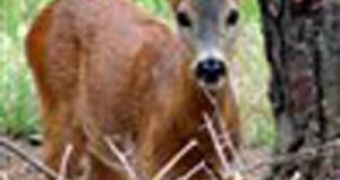The photograph featured here presents a one-year old deer born in captivity at the research center park in the Tuscan town of Prato, near Florence, Italy, which has a single horn placed towards the center of its head, similar to the unicorns fabled in popular myths. The photograph was released yesterday by Gilberto Tozzi, director of the Center of Natural Sciences, who believes that the unique features could have been determined by a genetic mutation, since its twin has two horns.
"This is fantasy becoming reality. The unicorn has always been a mythological animal", said Gilberto Tozzi in an interview following the release of the photo. Because this is the first time such an anomaly is reported, Tozzi reckons that similar genetic mutations in deer could have been the source of inspiration for the appearance of mythical unicorns.
Unicorns are described as being creatures resembling a horse, with a single spiraling horn in the center of their head, a billy-goat beard, the tail of a lion, cloved hooves and magical healing powers. Although, the modern image of a unicorn is pictured only as a horse with a horn in the center of its head, the other described features are allegedly specifically present in myths in order to make a clear distinction between horses and unicorns.
The mythical creature we call unicorn is said to be the only beast that was not created out of the human fears, being fierce but good, solitary, mysterious and beautiful at the same time. People would never try to tame it or capture it, and if so then it would mostly be for all the wrong reasons. The single horn in the center of its head is said to be able to neutralize poison.
"This shows that even in past times, there could have been animals with this anomaly. It's not like they dreamed it up", Tozzi added. Not that single horned deer haven't been spotted before, but the young deer nicknamed 'Unicorn' has its horn positioned straight at the center of its head.
"Generally, the horn is on one side of the head rather than being at the center. This looks like a complex case", said Fulvio Fraticelli, scientific director of the zoo in Rome. Such a unique positioning could have been caused by a traumatic event during the early life of the animal.
Researchers also believe that aside from single horned deer other animals such as the narwhal and whales with long, spiraling tusks might have contributed over time to the development and the evolution of the myth of the unicorn.

 14 DAY TRIAL //
14 DAY TRIAL //